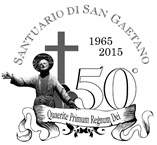Monumenti da visitare nel centro di Napoli
Monument to Saint Cajetan
 In the heart of the Neapolitan agora, today's Piazza San Gaetano, next to the Basilica San Paolo Maggiore, the bronze statue of saint Cajetan – the founder of the Theatine religious order who lived in this Basilica from 1538 until his death in 1547 and whose rests are kept there – raises.
In the heart of the Neapolitan agora, today's Piazza San Gaetano, next to the Basilica San Paolo Maggiore, the bronze statue of saint Cajetan – the founder of the Theatine religious order who lived in this Basilica from 1538 until his death in 1547 and whose rests are kept there – raises.
This monument was erected as an exvoto to thank the saint for having saved the city from a long-lasting and terrible plague which slaughtered the population in 1656.
On august 7th 1656, the day of Saint Cajetan's birthday and also the last day of the novena made by the whole city, the delegates of Naples six noble companies (namely Sedili di Forcella, Porto, Capuana, Montagna, Nilo and Portanova) and of one popular company (Sedile di Popolo) processioned from the town-hall in San Lorenzo Maggiore to the nearby church of San Paolo Maggiore, barefoot, with a rope around their neck, and "with all their honours and coats of arms on".
Once arrived, after being confessed and having received communion, they appealed to the blessed Cajetan to be liberated from this plague, taking a vow to have him ascribed among the saint patrons of Naples.
Taken this vow, the plague, at its climax, unexpectedly and miraculously ceased and from that moment there were no more dead, as proven by the reports made by all the city authorities, governors and hospices attendants.
 Hence a delegation of the local nobility appealed to Pope Alexander VII to have the blessed Cajetan among Naples saint patrons.
Hence a delegation of the local nobility appealed to Pope Alexander VII to have the blessed Cajetan among Naples saint patrons.
On behalf of their foundness and gratitude towards their saint founder, the Theatine fathers gave the famous jeweller and caster De Angelis their money to realize a bronze statue representing saint Cajetan with a shield bearing the image of the Immaculate Virgin.
The statue would have been positioned close to the church of San Paolo Maggiore, on the top of a votive column (guglia) commissioned to the architect Cosimo Fanzago.
Unfortunately the positioning of the statue in Piazza San Gaetano underwent a number of difficulties which resulted in the delaying of its realization.
During the restoration work at the archbishopric's bell-tower a white and light blue venitian marble column - about 6,75 m high and 1 m large - was found, and Cardinal Filomarino intended to turn it into a votive column to saint Gennaro but, due to some differences of opinion with the town authorities, nothing was decided and the column, for want of Cardinal Innico who succeeded Cardinal Filomarino, was offered to the viceroy D. Pietro D'Aragona who had in mind a guglia to be dedicated to the Immaculate Conception in Piazza Trinità Maggiore (today's Piazza del Gesù Nuovo), then eventually erected only in 1748.
A dispute with the owner of a nearby building prevented the column to be used and the viceroy eventually donated it to the Theatine fathers, who thought to use it as a base for saint Cajetan's bronze statue in Largo San Paolo, instead of the guglia already commissioned to Cosimo Fanzago.
Also in this case the owner of the nearby building strongly opposed to the erection of the votive column afraid of a possible damage of his property in case of the collapse of the column.
There was no way to come to an agreement and saint Cajetan's votive column - or guglia - was never edified, even though that building was more than once damaged by fires!
Only in 1737 the bronze statue was positioned over the marble base which was supposed to receive the great marble column.
The marble base is also adorned with four angels realized by the sculptor Andrea Falcone, at the expense of the Duke of Montenero, Don Alfonso Carafa, as a symbol of his devotion to saint Cajetan and in memory of his uncle the Theatine father Francesco Maria Carafa, then bishop of Nola, always eager to see the statue in the Piazza.
The statue of saint Cajetan, with his arms open to the faithful, is placed on the base of a column.
The halo which crowns the saint's head is a copy of the original one which was made of silver and stolen during the XXth century.

